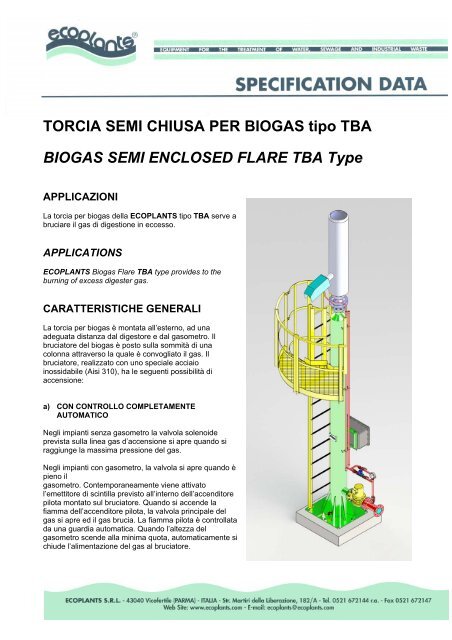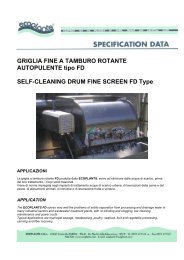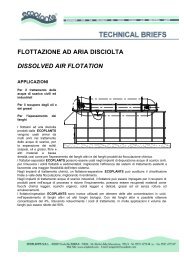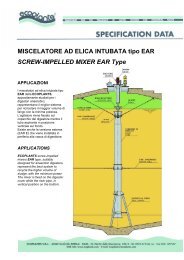TORCIA SEMI CHIUSA PER BIOGAS tipo TBA BIOGAS SEMI ...
TORCIA SEMI CHIUSA PER BIOGAS tipo TBA BIOGAS SEMI ...
TORCIA SEMI CHIUSA PER BIOGAS tipo TBA BIOGAS SEMI ...
Create successful ePaper yourself
Turn your PDF publications into a flip-book with our unique Google optimized e-Paper software.
<strong>TORCIA</strong> <strong>SEMI</strong> <strong>CHIUSA</strong> <strong>PER</strong> <strong>BIOGAS</strong> <strong>tipo</strong> <strong>TBA</strong><br />
<strong>BIOGAS</strong> <strong>SEMI</strong> ENCLOSED FLARE <strong>TBA</strong> Type<br />
APPLICAZIONI<br />
La torcia per biogas della ECOPLANTS <strong>tipo</strong> <strong>TBA</strong> serve a<br />
bruciare il gas di digestione in eccesso.<br />
APPLICATIONS<br />
ECOPLANTS Biogas Flare <strong>TBA</strong> type provides to the<br />
burning of excess digester gas.<br />
CARATTERISTICHE GENERALI<br />
La torcia per biogas è montata all’esterno, ad una<br />
adeguata distanza dal digestore e dal gasometro. Il<br />
bruciatore del biogas è posto sulla sommità di una<br />
colonna attraverso la quale è convogliato il gas. Il<br />
bruciatore, realizzato con uno speciale acciaio<br />
inossidabile (Aisi 310), ha le seguenti possibilità di<br />
accensione:<br />
a) CON CONTROLLO COMPLETAMENTE<br />
AUTOMATICO<br />
Negli impianti senza gasometro la valvola solenoide<br />
prevista sulla linea gas d’accensione si apre quando si<br />
raggiunge la massima pressione del gas.<br />
Negli impianti con gasometro, la valvola si apre quando è<br />
pieno il<br />
gasometro. Contemporaneamente viene attivato<br />
l’emettitore di scintilla previsto all’interno dell’accenditore<br />
pilota montato sul bruciatore. Quando si accende la<br />
fiamma dell’accenditore pilota, la valvola principale del<br />
gas si apre ed il gas brucia. La fiamma pilota è controllata<br />
da una guardia automatica. Quando l’altezza del<br />
gasometro scende alla minima quota, automaticamente si<br />
chiude l’alimentazione del gas al bruciatore.
) CON CONTROLLO <strong>SEMI</strong>-AUTOMATICO<br />
In questi impianti la fiamma pilota deve bruciare continuamente; è controllata da una guardia automatica<br />
della fiamma.<br />
GENERAL<br />
The Biogas Flare is mounted outside at a suitable distance from the digester and the gas holder. The gas<br />
burner is fitted on the top of a column through which the gas is piped. The gas burner is supplied in special<br />
stainless steel AISI 310 with the following arrangements for ignition:<br />
a) WITH FULLY AUTOMATIC CONTROL<br />
In plants without gas holder, the solenoid valve in the ignition gas-line is opened when the maximum gas<br />
pressure is reached.<br />
In plants with a gas holder, the valve is opened when the gas container is filled. At the same time the spark<br />
emitter within the pilot flame igniter at the gas burner is activated. As soon as the flame is burning in the pilot<br />
flame igniter, the main gas valve is opened and the gas is ignited. The pilot flame is controlled by an<br />
automatic flame guard. When the gas holder height is reduced to the minimum setting, the gas feed to the<br />
burner is automatically closed.<br />
b) WITH <strong>SEMI</strong>-AUTOMATIC CONTROL<br />
In these plants, the ignition flame must burn continually; it is controlled by an automatic flame guard.<br />
MODELLO<br />
STD. SIZE<br />
SELEZIONE TORCE <strong>PER</strong> <strong>BIOGAS</strong><br />
SELECTION OF <strong>BIOGAS</strong> FLARES<br />
PORTATA<br />
CAPACITY<br />
ATTACCHI <strong>TORCIA</strong><br />
FLARE PIPE<br />
CONNECTIONS<br />
INGRESSO<br />
INLET<br />
DRENAGGIO<br />
DRAIN<br />
2 Tba1.doc<br />
ALTEZZA<br />
HEIGHT<br />
Nm 3 /h DN " m<br />
<strong>TBA</strong>-1 60 50 3/4 4,0<br />
<strong>TBA</strong>-2 100 65 3/4 4,0<br />
<strong>TBA</strong>-3 150 80 3/4 5,0<br />
<strong>TBA</strong>-4 300 100 3/4 6,0<br />
<strong>TBA</strong>-5 500 125 1 6,5<br />
<strong>TBA</strong>-6 800 150 1 7,5<br />
<strong>TBA</strong>-7 1200 200 1 9,0<br />
<strong>TBA</strong>-8 1600 200 1 10,5<br />
<strong>TBA</strong>-9 2200 250 1 12,0<br />
<strong>TBA</strong>-10 2600 250 1 15,0<br />
H
COMBUSTION BASICS<br />
PRINCIPI DELLA COMBUSTIONE<br />
La reazione di base che rilascia la maggioranza<br />
dell'energia all'interno del biogas è la combustione di<br />
metano:<br />
CH4 + 2CO2 --- CO2 + 2H20<br />
Stechiometricamente, per realizzare l’ossidazione<br />
completa, occorrono 9,6 volumi di aria per volume di<br />
metano. Per una composizione tipica di biogas tale<br />
valore scende a 5,7:1. Similmente la produzione di<br />
energia da metano puro è di 36 MJ/m3 (valore<br />
calorifico superiore) mentre scende a 21 MJ/m3 per il<br />
biogas.<br />
Le torce per biogas operano con un eccesso di aria<br />
rispetto al biogas dell'ordine di 10-15 volumi di<br />
air:biogas. Sotto queste condizioni l'aria è utilizzata<br />
sia per ossidare il biogas che per raffreddare la<br />
fiamma. inoltre propaga più turbolenza e<br />
miscelazione. Mescolare durante la combustine è<br />
cruciale per assicurare che il biogas sia bruciato<br />
uniformemente ed in condizioni ideali.<br />
Il dimensionamento delle torce di biogas deve<br />
puntare a massimizzare la conversione di metano per<br />
minimizzare la liberazione di metano incombusto ed<br />
altri prodotti di ossidazione incompleta come il<br />
monossido di carbonio. Questo non è l'unico sottoprodotto<br />
indesiderato della combustione del biogas.<br />
Si possono generare altri prodotti che non dipendono<br />
solo dal rapporto aria:combustibile ma anche dalla<br />
temperatura e dalle cinetiche delle reazioni di<br />
combustione:<br />
- HC parzialmente ossidati<br />
- Diossine e Furani<br />
- PAH (Idrocarburi Policiclici Aromatici)<br />
- NOx (Ossidi di Azoto)<br />
The basic reaction that releases the majority of the energy within the biogas is the combustion of methane:<br />
CH4 + 2CO2 --- CO2 + 2H20<br />
Stoichiometrically we require 9.6 volumes of air per volume of methane to achieve complete oxidation. For<br />
the typical biogas composition given above this falls to 5.7:1. Similarly the energy release by pure methane<br />
is 36 MJ/m 3 (gross calorific value) but this falls to 21 MJ/m 3 for biogas.<br />
Biogas flares usually operate with the excess air to biogas ratio of the order of 10-15 volumes of air:biogas.<br />
Under these conditions the air is employed to both oxidize the biogas and cool the flame – it also propagates<br />
more turbulence and mixing. Mixing within the burn is crucial to ensure that all the biogas is burned uniformly<br />
and under ideal conditions.<br />
Biogas flare designs should aim to maximize the conversion of methane in order to minimize the release of<br />
unburned methane and any products of incomplete oxidation such as carbon monoxide. This is not the only<br />
3 Tba1.doc
unwanted bi-product of biogas combustion. Other species may be formed depending not only on the ratio<br />
air:fuel but also the temperature and kinetics of the combustion reactions:<br />
- Partially Oxidized HC<br />
- Dioxins and Furans<br />
- PAH (Polycyclic Aromatic Hydrocarbons)<br />
- NOx (Nitrogen Oxides)<br />
MANUTENZIONE<br />
Le torce per biogas non necessitano di manutenzione speciale.<br />
Per la pulizia della colonna, la rimozione delle particelle di fango e della<br />
condensa depositate, è prevista, alla base, una tubazione di scarico.<br />
Verificare periodicamente:<br />
La perfetta tenuta delle valvole sulla linea gas<br />
La pulizia dell’arrestatore di fiamma<br />
Lo stato del bruciatore pilota (isolatore ceramico ed elettrodi)<br />
MAINTENANCE<br />
Biogas flares do not need special maintenance.<br />
For cleaning the column, to remove settled sludge particles and<br />
condensation water, there is a pipe for washing and discharging on the<br />
base of the column.<br />
From time to time check as follows:<br />
The perfect seal of valves in gas-line<br />
The flame arrester should be perfectly cleaned<br />
The pilot burner (ceramic insulator and electrodes)<br />
Pannello di controllo (Atex EExd)<br />
Control panel (Atex EExd)<br />
Accenditore pilota<br />
Pilot burner<br />
Arrestatore di fiamma (Atex)<br />
Flame arrester (Atex)<br />
4 Tba1.doc





